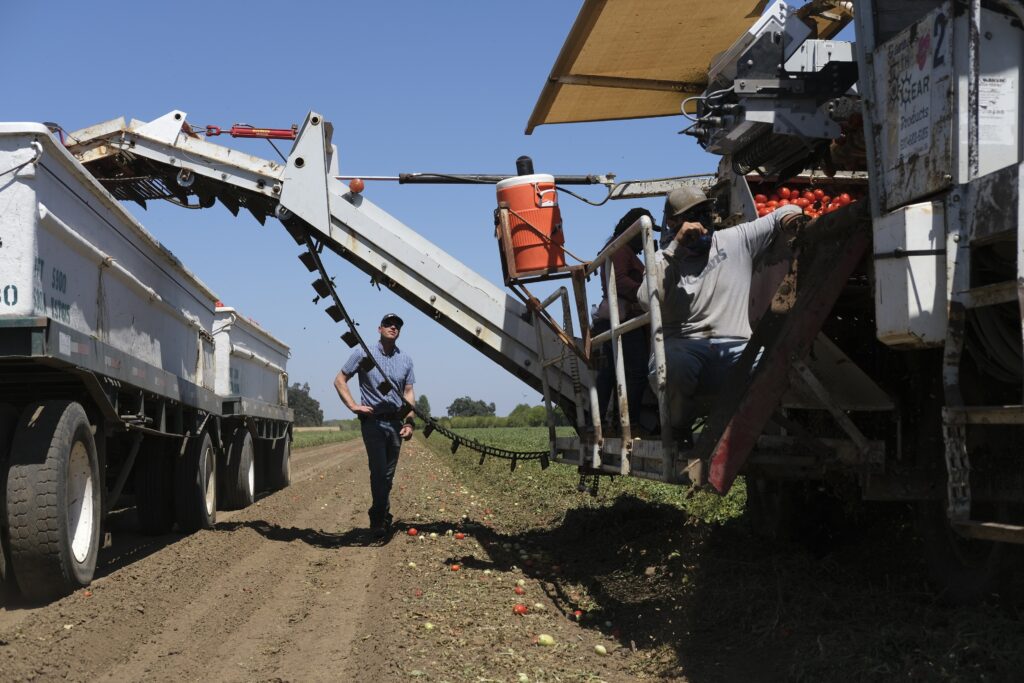Aug 16, 2024Searing heat, reduced plantings harming California processing tomato crop
California’s processing tomato crop is being harmed by intense heat and reduced plantings.
California farmers began harvesting processing tomatoes across the Central Valley in late July.
With searing heat waves impacting pollination for some plantings and harvest for others, growers said they were anticipating average yields at best.
“Everyone says it’s about an average year, maybe off a little bit,” said Mitchell Yerxa, who grows tomatoes in Sutter and Colusa counties for his family’s River Vista Farms and serves on the board of the California Tomato Growers Association.
The crop was already set to be a light one. Tomato processors contracted 40,000 fewer acres from farmers this year due to bolstered inventory from last year’s bumper crop, aiming to process about 10% less tonnage, according to the U.S. Department of Agriculture.

“Every grower for the most part has been reduced,” Mike Montna, president and CEO of the CTGA, said in the spring.
Fresno County led the state in planted tomato acreage, followed by Yolo, Kings, Merced and San Joaquin counties. As of last week, about a quarter of the state’s crop was harvested, according to industry reports that analyze data from processors.
Lauren Caldas, field manager for Modesto-based Stanislaus Food Products, said the cannery had finished receiving tomatoes from Kern County and was shifting its focus to Fresno County before getting tomatoes from the northern end of the valley beginning the second week of August.
“The crop was a little bit light, but we had some shining spots,” Caldas said of the Kern County haul. “Quality has been fairly good this year.”
Organic tomatoes harmed
Don Cameron, vice president and general manager of Terranova Ranch, which grows organic and conventional processing tomatoes in Fresno County, said his organic crop, which he harvested first, produced a lower yield this year.
Cameron attributed the lighter crop to a mid-July heat wave. “It didn’t help that we were up to 110 degrees during harvest,” he said.
A separate heat wave sent Central Valley temperatures soaring into triple digits for several days in early June. Farmers said the springtime heat, which came during fruit set for some plantings, appeared to have impacted fertilization.

“We might have some pollination issues in the middle of the crop,” said Tommy Bottoms, owner of Tremont Farms in Yolo and Solano counties. With low temperatures remaining close to 80 degrees some nights, “the pollen itself will just dry out, and so it’ll be less viable for the actual fertilization process,” he said.
Bottoms, who began harvesting tomatoes last week in Winters, said he could see the difference in fruit sets. “The stacking of the fruit—how it looks on the bed—it looks a little better earlier in the season,” he said.
Other growers and processors reported similar impacts. “Everyone is expecting that the end-season crop is going to be light because of the high-heat days that may have compromised some of the bloom,” Caldas said.
Bottoms said it was too early to judge his later plantings, but he expected his overall yield would be “about at contract.”
Some regions reported increased pest and disease concerns for this year’s tomato crop. Several counties in the San Joaquin Valley proactively declared local emergencies to give farmers access to stronger insecticides to fight beet leafhoppers.
The pest spreads curly top virus, which can devastate tomato crops. So far, curly top virus losses have been “nothing dramatic” this year, Yerxa said.
Caldas of Stanislaus Food Products estimated the overall processing tomato crop “is going to be a little bit short but not significantly short.”
She added she was confident the cannery would get enough tonnage so that consumers wouldn’t feel the impact of a shortfall. “We always contract enough to get what we need to provide products to our end user,” Caldas said.
With canneries primarily cutting tonnage from late-season deliveries, growers and processors said they anticipated finishing harvest much earlier than last year, when cool weather conditions kept fruit in the field through November.
“I don’t anticipate us going into October this year,” Caldas said.
Growers said that while tomato prices dropped this year, falling from last year’s $138 per ton to $112.50 per ton, the crop remains a reliable one from a business perspective.
“People still say processing tomatoes are the shining star in the row-crop industry,” Bottoms said. With input costs remaining high, “our margins in tomatoes have become less,” he said, “but they’re still better than a lot of other crops.”
“If we get an average crop, we will be profitable,” Cameron said.

Photo courtesy Caleb Hampton.
After processors cut tomato contracts this year, farmers said they filled the ground with rotational crops such as corn, beans and hay, which improve long-term soil health but can hurt short-term profits.
“Crop prices are down across the board, so it’s not like you have a lot of other choices,” Yerxa of River Vista Farms said.
He said he planted corn and vine seed for squash, cucumber and watermelon on his acreage where tomato production was cut.
Cameron of Terranova Ranch said organic tomato contracts were slashed more sharply than conventional ones, and it was difficult to find marketable crops to fill the ground.
“We ended up growing some organic corn, which usually is not very profitable,” he said. “A lot of the other crops being grown this year, prices are down and growers are struggling.”
With tomato processors likely to determine next year’s contracts based on the size of this year’s crop, Bottoms said, “Everybody is watching the tomato industry pretty closely.”
— Caleb Hampton, California Farm Bureau’s Ag Alert

















